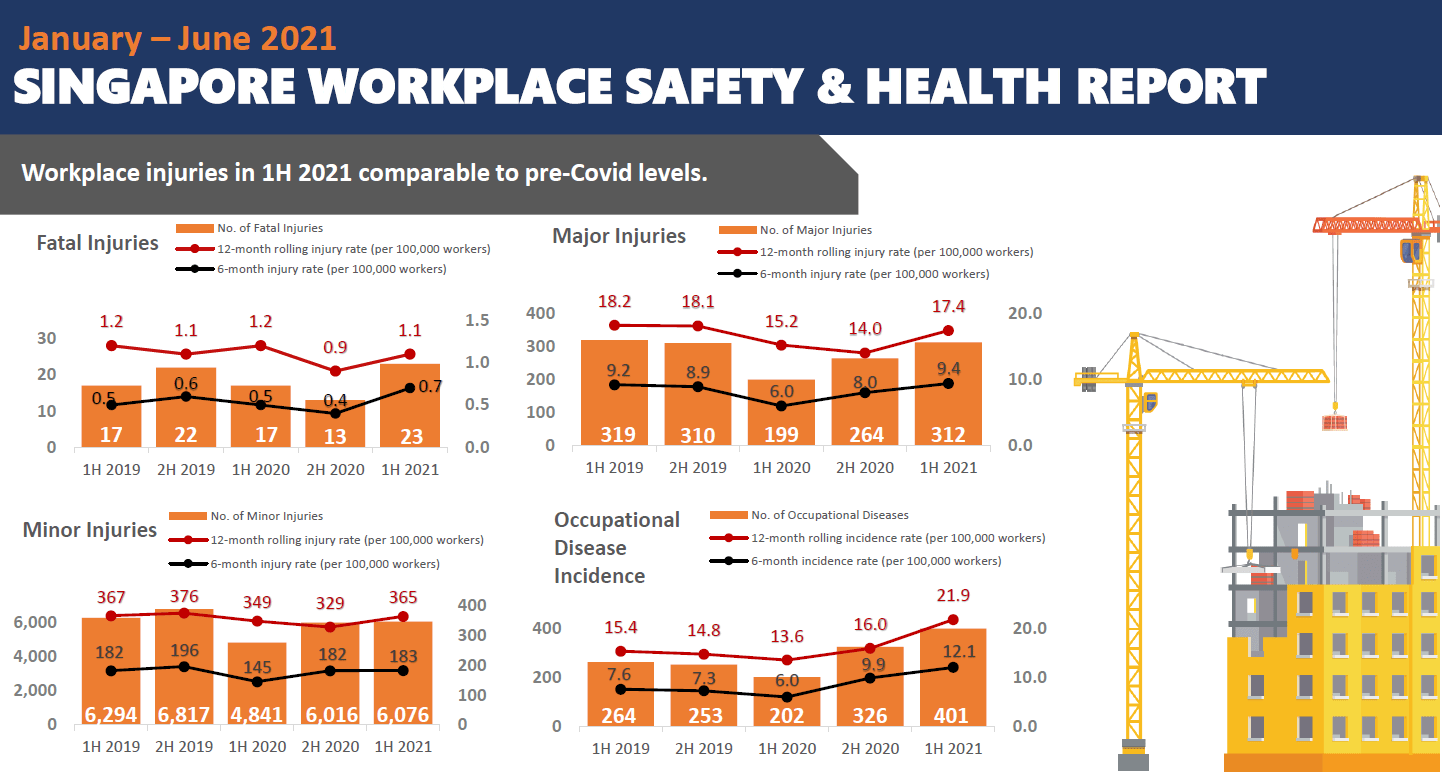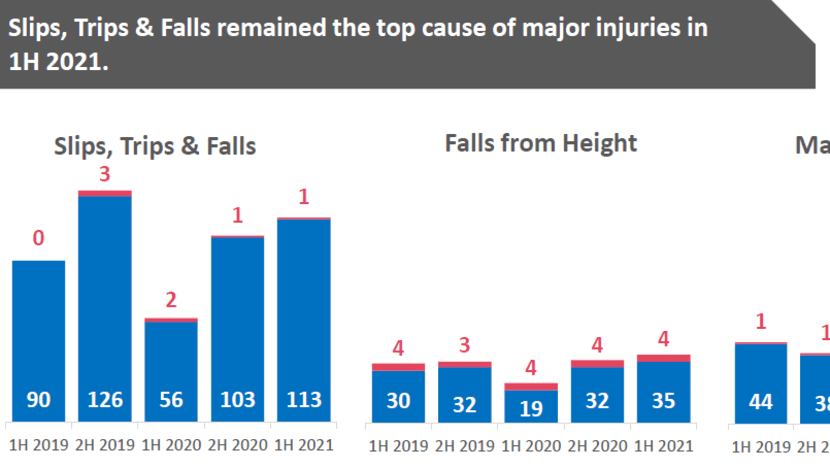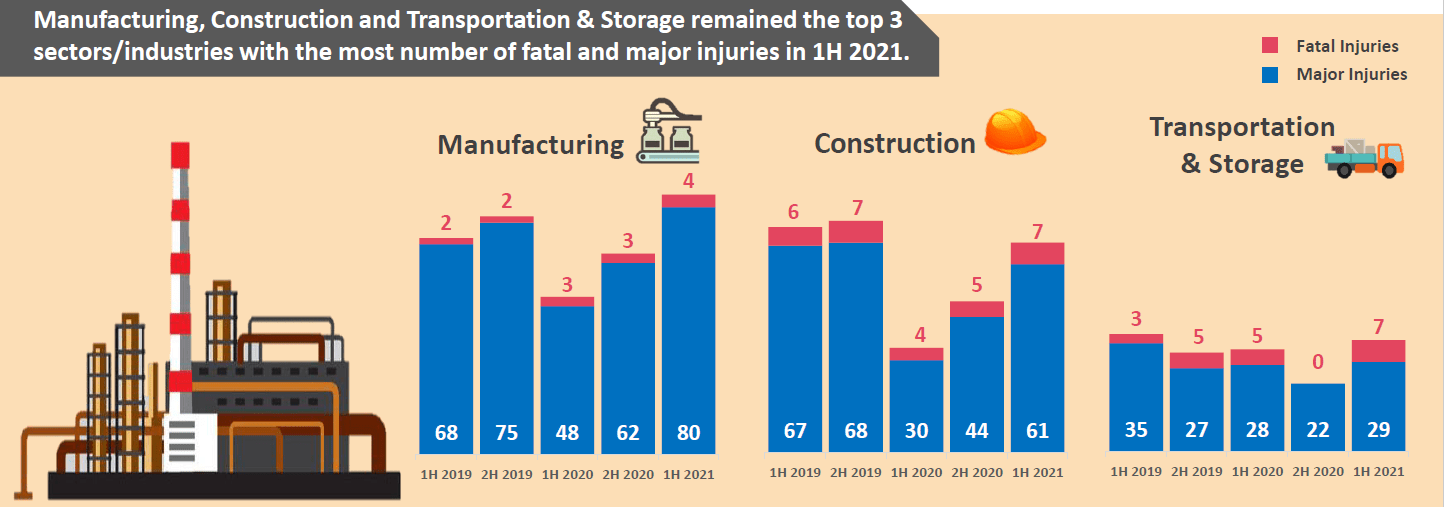Workplace injuries in first half of 2021 comparable to pre-COVID-19 levels, but fatal accidents a 'cause for concern': MOM
SINGAPORE: The rate of workplace injuries in the first half of 2021 was comparable to pre-COVID levels, said the Ministry of Manpower in a report on Friday (Oct 8).
There were 193 injuries per 100,000 workers during this period, compared to 205 injuries per 100,000 workers during the second half of 2019.
The workplace fatality rate has also remained similar to pre-COVID-19 levels with 0.7 fatalities per 100,000 workers, compared to 0.6 in the second half of 2019. However, this marked an increase from the 0.4 fatalities per 100,000 workers in the second half of last year.
The ministry said that the increased number of workplace injuries and fatalities compared to the second half of 2020 was the result of the gradual resumption of workplace activities since the second quarter of last year.
There were a total of 6,411 injuries and 23 fatalities in the first half of 2021, compared to 6,293 injuries and 13 fatalities in the second half of last year.
"Despite the fluctuations, significant progress has been made pre-COVID to bring down workplace injuries," said MOM.
"Everyone has a part to play to meet our goal of reducing and sustaining Singapore’s annual workplace fatality rate to below 1.0 per 100,000 workers by 2028, an outcome consistently achieved by only four Organisation for Economic Co-operation and Development (OECD) countries."

The top causes of workplace fatalities in the first half of 2021 continue to be vehicular incidents, with six fatalities, and falls from height, with four fatalities.
Of the six vehicular-related fatalities, four were work-related traffic accidents involving delivery or dispatch riders. Of these, three were due to the negligence of other road users.

Slips, trips and falls remain the leading cause of non-fatal injuries, with the number of related major injuries increasing slightly from 103 in the second half of 2020 to 113 in the first half of this year. However, related minor injuries fell to 1,753 in the first six months of 2021 from 1,846 in the second half of last year.
Machinery-related incidents were another common cause of injuries, accounting for 33 major injuries in the first half of 2021, up from 30 in the previous six months. There were 968 minor related injuries in the first half of 2021, up from 912 minor injuries in the second half of last year.
MOM PAYING CLOSE ATTENTION TO MANUFACTURING INDUSTRY
MOM said that it is "paying close attention" to the manufacturing industry, which has a 6-month fatality rate of 1.0 per 100,000 workers, or four fatalities, compared to the second half of 2020, which saw three fatalities, or 0.8 per 100,000 workers.
It also had the highest number of non-fatal injuries, with 80 major injuries and 1,364 minor injuries in the first half of this year.

Construction, as well as transportation and storage, accounted for the highest number of fatalities, with seven each in the first half of 2021. Collectively, they accounted for over 60 per cent of all fatalities during this period, said the ministry.
The 6-month workplace fatality rate for the construction industry increased to 1.7 per 100,000 workers in the first half of 2021, from 1.2 in the second half of last year. During the same period, the 6-month workplace fatality rate in the transportation and storage industry increased from zero to 2.8 per 100,000 workers.
The number of dangerous occurrences – incidents with a high potential for multiple fatalities – increased from six in the second half of 2020 to seven in the first half of 2021, as business activities continue to ramp up. Of these, six were due to collapse or failures of structures and equipment, while one was due to a fire and explosion incident at Tuas which resulted in three fatalities and seven injuries.
The rate of occupational diseases cases grew to 12.1 cases per 100,000 workers, from 9.9 in the second half of 2020. This increase was largely due to work-related COVID-19 cases, and delayed medical assessment due to COVID-19 disruptions, said MOM. Work-related musculoskeletal disorders and noise-induced deafness remained the leading cause of occupational diseases, jointly accounting for 68 per cent of the total number in the first half of 2021.
SPATE OF FATAL ACCIDENTS A CAUSE FOR CONCERN
MOM said that the spate of fatal accidents in the first half of 2021 was a cause for concern, urging companies to prioritise workplace safety and health, even as they manage manpower constraints and project schedules.
To reinforce this, the Workplace Safety and Health (WSH) Council partnered industry associations and unions to conduct safety time-out exercises in March and June. Employers were strongly encouraged to review control measures and workers to follow safe work procedures.
“The spate of fatal accidents this year, including February’s explosion in Tuas that resulted in multiple casualties, serves as a reminder of the catastrophic consequences when safety practices are ignored or compromised," said Silas Sng, commissioner for workplace safety and health.
"As companies continue to navigate the challenging operating environment in the midst of this pandemic, I urge all companies to review their risk assessments and control measures to protect the safety and health of their workers," said Mr Sng, who is also divisional director of MOM’s occupational safety and health division
The ministry has also stepped up enforcement operations, including those which focus on combustible dust at workplaces, following the Tuas explosion incident.
More than 500 companies were inspected, with three found to have inadequate control measures in place and issued with stop-work orders.
From May to July, more than 500 inspections were conducted in high-risk sectors such as manufacturing and construction, with a focus on machinery safety. Of these, 70 per cent resulted in contraventions being uncovered. Top contraventions included poorly maintained machinery/equipment, inadequate guarding of machinery, ineffective barricades/guard-rails and unsafe stacking of materials.
To address the rising number of work-related traffic accidents, a food and courier delivery workgroup has been formed, comprising tripartite partners including the WSH Council, the National Delivery Champions Association and companies such as GrabFood and Singpost. The Workgroup will discuss progressive practices that employers and intermediaries can adopt, such as safety training for new riders.
MOM has also started to identify emerging rider safety technology solutions such as collision alert systems and rider behaviour monitoring systems.
These will be test-bedded with logistics and food delivery companies. An enforcement operation on vehicular safety will be conducted from October to November, targetting transportation and storage, construction, and manufacturing, where workplace traffic hazards are common.


















